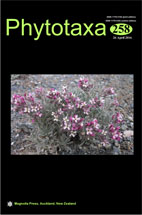Abstract
Mansoa (Bignoniaceae: Bignonieae) is a Neotropical genus of lianas distributed through Wet and Seasonally Dry Forests. The genus is characterized by striated bark, extrafloral nectaries on the abaxial surface of leaflets, trifid tendrils, and garlic odor. During a taxonomic revision of the genus, five new species were discovered in South America, increasing to 16 the number of recognized species in Mansoa. Four of these taxa, Mansoa ivanii, Mansoa longicalyx, Mansoa minensis and Mansoa paganuccii, are restricted to eastern portions of Brazil, while Mansoa gentryi is found in Peruvian rainforests. Mansoa ivanii, M. longicalyx, and M. minensis share pubescent branches and leaflets with Mansoa hirsuta, but differ by the corolla length and calyx morphology. Mansoa paganuccii shares ovate to elliptic leaflets and a lack of garlic odor with Mansoa difficilis and Mansoa angustidens, but differs by the serrate leaflets and mucronate calyx. Mansoa gentryi shares chartaceous and elliptic leaflets with Mansoa alliacea, but differs by the pinnate venation and ribbed capsules.

